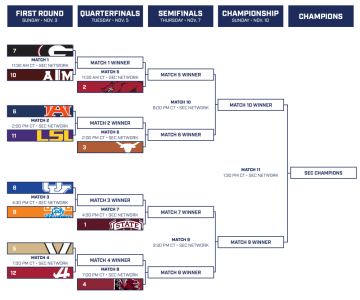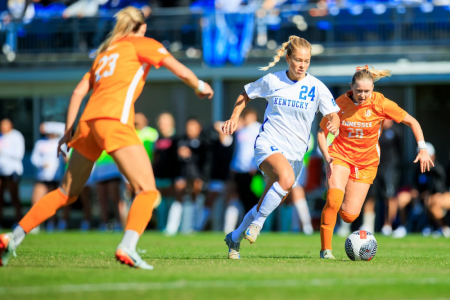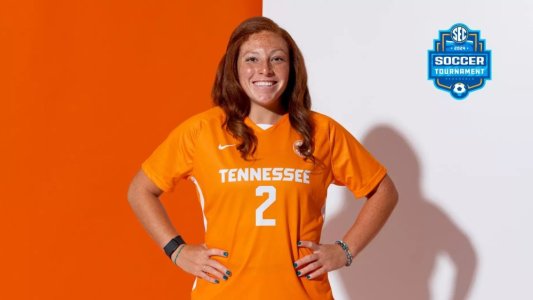Historic House-NCAA settlement leaving hundreds of Olympic sport athletes in peril
On Nov. 13, college athletes across the country can sign financial aid agreements with their chosen university.
While the NCAA eliminated the National Letter of Intent program, signing day remains in place as a seminal moment for college-bound athletes to make their verbal commitments binding. It is traditionally a celebrated day.
For some, that’s not the case this year.
Hundreds of college prospects, many of them participating in Olympic sports, are in a precarious position as the signing date approaches. Schools have eliminated roster spots and, for some, scholarship offers that they were once promised. Meanwhile, several dozen current college athletes are being notified that they are no longer part of their teams — some of the notifications arriving after the fall semester even began.
The actions are a result of a significant and overshadowed roster change affiliated with the NCAA’s historic settlement of an antitrust lawsuit (House). While the NCAA and power conferences agreed to expand upon scholarships as part of the settlement,
they also imposed roster limits for sports, many of which did not previously exist.
Such a change will result in thousands of lost roster spots for mostly walk-on athletes and those on partial scholarship — a consequence that, while previously reported by Yahoo Sports, has now sparked outrage from hundreds of parents of athletes or prospective athletes whose spots have been or will soon be eliminated.
Nearly 20,000 parents and athletes are members of a Facebook page related to the issue, and they are mobilizing in what is now a public fight against the new policies, said Tom Wiegand, an attorney with MoloLamken, a national firm based in New York, Washington D.C. and Chicago. The firm is in the process of authoring an objection to the settlement over the roster limits, he told Yahoo Sports this week.
“The roster limit is one of several significant flaws of the settlement,” he said. “We’re pursuing our objection in the hope the court will fix this settlement to be truly fair to all impacted by it.”
How it is impacting current and future athletes
More than a dozen parents of current college athletes or recruits spoke to Yahoo Sports for this story. They were granted anonymity for fear of negative impacts to their children.
Their stories range widely across a variety of sports. A beach volleyball recruit, committed to a Big 12 program for months, was recently told the spot no longer exists. A sophomore cross country runner for an SEC team was notified by email that she was cut from the team two days after the semester began. Yahoo Sports obtained a copy of the email.
At one SEC school, eight track and field runners were cut or pushed out over the summer. One power conference program released all of their 2025 men’s swimming commitments. And in football, it is estimated that more than 1,500 walk-on players — roughly 20-30 per team — will see their spots cut.
In all, the 68 power conference schools are expected to eliminate at least 3,000 roster positions as administrators work to adhere to new roster limitations, reallocate resources from lower-tier to revenue-generating sports, and balance men and women opportunities to comply with the federal Title IX law.
The settlement concepts — the new roster structure and direct athlete revenue-sharing — is expected to take effect next July. While the settlement has yet to be formally approved, schools are “making roster adjustments now,” said Samantha Barany, executive director for the College Swimming and Diving Coaches Association of America. “Anybody who has been recruited is being re-evaluated.”
The
settlement is a groundbreaking and landmark agreement between the defendants (NCAA and power conferences) and the plaintiffs (those suing mostly over athlete-compensation restrictions). The deal features three main parts: (1) nearly $2.8 billion in backpay to former athletes distributed over a 10-year period; (2) a revenue-sharing concept permitting schools to share as much as $23 million annually with their athletes; and (3) the overhauled roster structure.
In an interview Thursday with Yahoo Sports, Steve Berman, one of the lead plaintiff attorneys who struck the settlement with the NCAA, acknowledged the elimination of roster spots. However, Berman told Yahoo Sports, “overall the settlement is a good thing, but some people are being affected who were promised a roster spot and now it is not there.”
Plaintiff attorneys are “working” with the NCAA and power leagues for solutions, Berman said, including a transitional period in which those currently on a roster are grandfathered into the system.
An NCAA official declined comment on this when reached.
Power conference leaders were not immediately available for comment. Commissioners of the SEC, Big Ten, ACC and Big 12 were at the center of settlement negotiations and are expected to further assume more authority over the governance and enforcement in a post-settlement world.
Complex roster and scholarship structure
Under previous rules, most NCAA sports featured a scholarship limit (different by sport), but a few sports had a finite roster cap. For example, the sport of men’s volleyball was allotted just 4.5 scholarships but often kept on its roster as many as 25 players, or however many the school permitted.
As part of the new policy, scholarship caps were removed, replaced by formal roster limitations that permit schools — not require them — to offer scholarships to their entire rosters. While this will likely produce more scholarships, the roster caps will require the elimination of walk-on athletes and even, perhaps, some on partial scholarships (though both the settlement and NCAA rules prohibit existing scholarship athletes from losing his or her scholarship).
The difference between a sport’s new roster limit and its current roster are drastic in a handful of sports. Many cross country teams keep more than 30 runners on a roster. The new roster limit is 17. The new roster limit for men’s volleyball is 18 when many rosters are well over 20, said John Speraw, the new president and CEO of USA Volleyball who coached the men’s national team to a bronze medal in Paris.
“This is just from the volleyball perspective, but one of the larger consequences of this decision is the impact of young people to play this sport,” Speraw told Yahoo Sports. “There are significantly less opportunities for boys in our sport to play at schools they really wanted to go to. Next fall, there’s going to be a lot of kids getting cut.”
Roster limits are not the only reason behind the cuts.
The settlement also sets the stage for the era of direct revenue sharing from school to athlete — a concept that has administrators shifting resources from non-revenue sports to revenue giants football and men’s basketball. Title IX requirements put men’s Olympic sports further in jeopardy as well, as administrators attempt try to keep their resourcing balanced for men’s sports and women’s sports.
For example, to stay competitive in their most valuable sports, many programs are likely to increase scholarships in baseball and football. Baseball, currently at an 11.7 scholarship cap, will increase to a 34-man roster limit. Football, currently at 85 scholarships, will increase to 105. To comply with Title IX, any scholarships added on the men’s side are likely to be added on the women’s side too — unless programs reallocate men’s Olympic sport scholarships, taking from the non-revenue to feed the revenue.
“Someone might say we are taking better care of our student-athletes with the settlement. I’d say we are taking better care of a percentage of our student-athletes,” Barany said. “And those athletes ought to be taken care of. It’s the right thing, but don’t confuse it for the fact that it is not the overwhelming majority of athletes. There are a whole lot of our student-athletes who are vulnerable.”
Craig Bohl, director the American Football Coaches Association, describes the new roster structure as “perplexing” and said coaches are “distraught” over eliminating walk-ons — a process that will soon begin to prepare for the implementation next fall.
“College coaches are deeply concerned,” he said. “I was a walk-on. (Illinois coach ) Bret Beliema was a walk-on. Dabo Swinney was a walk-on.”
What's the best solution in a 'messy' time in college athletics?
Some college administrators have been quite open about what SEC commissioner Greg Sankey describes as a “messy” time amid historic change. Wisconsin athletic director Chris McIntosh told BadgerExtra that the school will reduce its total athlete population by 80-100. Ohio State athletic director Ross Bjork put his estimate at 150. The Buckeyes have one of the largest athletic departments in the country, offering 36 sports.
“The beginning of change — it’s new and fancy,” Sankey said last week, not speaking specifically about the roster situation but the transformation as a whole. “You get to a finish line and you think you’ve accomplished something. In the middle of anything is messy. This is messy.”
Parents are wondering aloud why it has to be so messy.
Why were roster and scholarship changes made at all? Was it pertinent to the settlement?
According to those with knowledge of the negotiations, officials implemented the new roster structure as a way to preemptively avoid any legal action over the scholarship restrictions. They also wanted to give schools the opportunity to “increase the number of scholarships and support for players,” Berman said.
Meanwhile, officials in individual conferences are discussing creating their own roster and scholarship limits on a conference-wide level that will work within the national standards, multiple officials involved in the discussion tell Yahoo Sports. The nature of those conversations is unclear.
The settlement’s impact on Olympic sports programs has long been discussed and dissected. Those sports are often subsidized by revenues from football, the same revenues that, presumably, will be used to distribute in any employment or revenue-sharing model.
During a roundtable discussion on Capitol Hill in March, Alabama athletic director Greg Byrne, presiding over one of the richest and most historic programs, said he uses the revenues from football and basketball to overcome a $40 million deficit from non-revenue sports.
“There’s not an unlimited amount of money as some believe,” Byrne told congressional lawmakers.
Athlete advocates, though, argue that administrators at the highest level have used the millions in excess football revenues to unnecessarily pay coaches millions, fatten their own salaries and build gaudy facilities. Either way, many schools stand at an inflection point with the college sports Olympic model in a perilous place.
Unlike most other countries around the globe, colleges serve as the very expensive farm system for the U.S. Olympic movement. At this year’s Games in Paris, 75% of U.S. Olympians have or plan to compete collegiately. Universities spend more than $5 billion on Olympic sports each year — most of which never turn a profit.
How the presiding judge in the House settlement will react to this latest objection remains unclear. Eliminating athlete opportunities appears to be an affront to her beliefs. During a September hearing in the case, California District Judge Claudia Wilken told NCAA and plaintiff attorneys, “I find that taking things away from people is usually not too popular.”
Despite the objection over roster limits, Berman believes the settlement will continue to “go forward,” he adds.
But many in college athletics have concerns.
“The irony is the House settlement has been made to benefit student-athletes,” said Jaime Gordon, the American Volleyball Coaches Association executive director. “I agree with the components of the settlement, but part of this is going to be at the expense of other student-athletes.”
For many, walk-ons or those on partial scholarship serve a paramount purpose. Their role goes well beyond practice dummies. Many schools use them as enrollment boosters, a clever way to increase student body numbers at a time when new freshman classes continue to shrink.
“Adding sports is a tried-and-true, cost-effective way of reversing the enrollment trend,” said Mike Moyer, the director of the National Wrestling Coaches Association. Wrestling teams will have a new roster limit of 30 while most schools keep 35-40 on a team.
“What might make sense for the power schools, may not make any sense for the mid-majors," Moyer continued. "It’s scary when you have things going on at the top end having a cascading effect.”
A walk-on spot, for the athletes themselves, is a time-honored and longstanding way to be part of a team while also earning financial benefits. To a school, they can be costly. Meals, medical care, travel costs and other stipends can run into the tens of thousands for walk-on athletes.
The mother of one cross country runner is anticipating that her daughter will soon be cut from her power conference team. Her and her husband estimate that their daughter receives more than $20,000 in annual benefits as a walk-on runner, including a summer stipend, medical care, Alston-related money, etc.
And where, if she is cut, does she go when other programs are doing the same?
“It’s detrimental,” she said. “You have this huge influx of people with nowhere to go.”
Another mother of a track athlete — the one cut via email after the semester began — said her daughter also lost academic-based aid for athletes.
“My daughter was not eating or sleeping,” she tells Yahoo Sports. “The mental distress of this is terrible.”


www.ncaa.com








